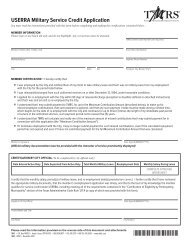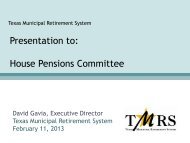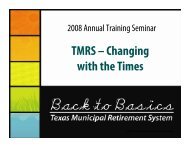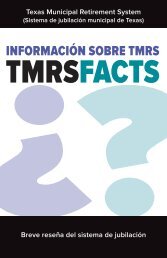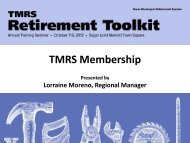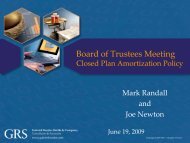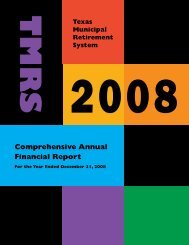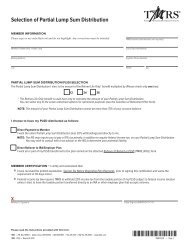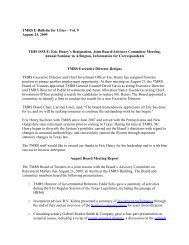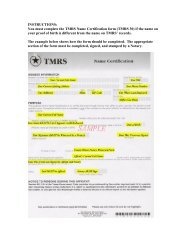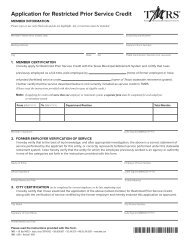3:30 pm June 22 - Texas Municipal Retirement System
3:30 pm June 22 - Texas Municipal Retirement System
3:30 pm June 22 - Texas Municipal Retirement System
You also want an ePaper? Increase the reach of your titles
YUMPU automatically turns print PDFs into web optimized ePapers that Google loves.
MINUTES OF THE<br />
TEXAS MUNICIPAL RETIREMENT SYSTEM<br />
Regular Meeting of the Board of Trustees<br />
<strong>June</strong> 21, 2012 – 3:<strong>30</strong> p.m.<br />
<strong>June</strong> <strong>22</strong>, 2012 – 8:<strong>30</strong> a.m.<br />
On <strong>June</strong> 21, 2012, the Board of Trustees of the <strong>Texas</strong> <strong>Municipal</strong> <strong>Retirement</strong> <strong>System</strong> (TMRS)<br />
convened for a meeting at 3:<strong>30</strong> p.m. at TMRS Headquarters, located at 1200 North IH 35 in<br />
Austin, <strong>Texas</strong>, with the following members present:<br />
Board of Trustees<br />
Frank Simpson, Chair<br />
Julie Oakley, Vice Chair<br />
April Nixon<br />
Jim Parrish<br />
Roel (“Roy”) Rodriguez<br />
Absent: Ben Gorzell, Jr.<br />
Present also were:<br />
David Gavia, Executive Director<br />
Eric Davis, Deputy Executive Director<br />
Bernie Eldridge, Director of Human Resources<br />
Nancy Goerdel, Chief Investment Officer<br />
Christine Sweeney, General Counsel<br />
Dan Wattles, Director of Governmental Relations<br />
Bill Wallace, Director of Communications<br />
Michelle Mellon-Werch, Associate General Counsel<br />
Stacy White, Executive Assistant<br />
Robert Klausner, Klausner Kaufman Jensen & Levinson<br />
Mr. Simpson called the meeting to order at 3:31 p.m. and Mr. Rodriguez gave the invocation.<br />
1. Executive Session<br />
At 3:33 p.m., the Board entered into Executive Session, pursuant to <strong>Texas</strong> Government Code<br />
§§551.071 and 551.074 to consult with Legal Counsel to receive legal advice, and to discuss<br />
personnel matters. No action was taken during the Executive Session and the meeting was<br />
opened to the public again at 4:56 p.m. All members of the Board who had been present<br />
when the Board went into Executive Session were again present. No public action was taken.<br />
At 4:56 p.m., the meeting recessed until 8:<strong>30</strong> a.m. on Friday, <strong>June</strong> <strong>22</strong>, 2012.<br />
Signed by David Gavia<br />
Signed by Frank Simpson<br />
__________________________________<br />
David Gavia<br />
Executive Director<br />
___________________________________<br />
Frank Simpson<br />
Chair, Board of Trustees
MINUTES OF THE<br />
TEXAS MUNICIPAL RETIREMENT SYSTEM<br />
Meeting of the Board of Trustees<br />
<strong>June</strong> 21, 2012 – 3:<strong>30</strong> p.m.<br />
<strong>June</strong> <strong>22</strong>, 2012 – 8:<strong>30</strong> a.m.<br />
On <strong>June</strong> <strong>22</strong>, 2012, the Board of Trustees of the <strong>Texas</strong> <strong>Municipal</strong> <strong>Retirement</strong> <strong>System</strong> (TMRS)<br />
convened for a meeting at 8:<strong>30</strong> a.m. at TMRS Headquarters, located at 1200 North IH 35 in<br />
Austin, <strong>Texas</strong>, with the following members present:<br />
Present also were:<br />
Board of Trustees<br />
Frank Simpson, Chair<br />
Julie Oakley, Vice Chair<br />
April Nixon<br />
Jim Parrish<br />
Roel (“Roy”) Rodriguez (arrived at 8:50 a.m.)<br />
Absent: Ben Gorzell, Jr.<br />
David Gavia, Executive Director<br />
Ian Allan, Director of Internal Audit<br />
Rhonda Covarrubias, Director of Finance<br />
Eric Davis, Deputy Executive Director<br />
Bernie Eldridge, Director of Human Resources<br />
Nancy Goerdel, Chief Investment Officer<br />
Bonnie Mitra, Director of Fixed Income<br />
Christine Sweeney, General Counsel<br />
Holly Macki, Director of Real Estate<br />
Michelle Mellon-Werch, Associate General Counsel<br />
Debbie Munoz, Director of Member Services<br />
Kristin Qualls, Director of Equities<br />
Dimitry Shishkoff, Director of Risk Management<br />
Bill Wallace, Director of Communications<br />
Dan Wattles, Director of Governmental Relations<br />
Stacy White, Executive Assistant<br />
Scott Willrich, Director of Information Resources<br />
Robert Klausner, Klausner Kaufman Jensen & Levinson<br />
Susan Warren, KPMG<br />
Diana Mayes, KPMG<br />
Marcia Beard, R. V. Kuhns & Associates<br />
Todd Shupp, R. V. Kuhns & Associates<br />
Page 1 of 10
Also in attendance:<br />
Nikolas Ballard, Pension Review Board<br />
Sherry Cha<strong>pm</strong>an, Investment Accountant<br />
David Crow, Arlington Fire Fighters<br />
Debbie Farahmandi, Investment Operations Specialist<br />
Chris Jones, Combined Law Enforcement Associations of <strong>Texas</strong> (CLEAT)<br />
Glenn Johnson, Garland Fire Fighters Association<br />
George Kauffman, City of Garland<br />
Scott Kerr, <strong>Texas</strong> State Association of Fire Fighters<br />
Randall Meadows, Arlington Police Association<br />
Jim Moore, Mesquite Fire Fighters<br />
Lorraine Moreno, Regional Manager – City Services<br />
Cindy Morse, Investment Support Analyst<br />
Candace Nolte, Controller<br />
Kate Reed, Investment Risk Analyst<br />
Katie Reissman, Investment Analyst – Fixed Income<br />
David Rodriquez, Regional Manager – City Services<br />
Mr. Simpson called the meeting to order at 8:34 a.m. and gave the invocation.<br />
2. Consider and Act on Performance and Compensation of Internal Auditor and General<br />
Counsel (taken out of order)<br />
Mr. Gavia reminded the Board that it sets the compensation of the Internal Auditor and the<br />
General Counsel and is not required to use regular staff merit increase guidelines in<br />
compensating either of these positions, based on Board Policy. During the 2012 budget<br />
process, the Board approved a 2.5% merit increase pool for one-half of the year to be<br />
awarded in accordance with the merit increase guidelines that were approved by our internal<br />
Compensation Committee for use in awarding 2012 merit increases. Discussion centered on<br />
the General Counsel’s salary compared to other similar positions. Mr. Parrish moved that the<br />
Board grant a 2.5% merit increase for the Director of Internal Audit. Ms. Nixon seconded<br />
the motion, which passed unanimously by all Board members who were present, 5-0. Ms.<br />
Nixon moved that the Board grant a 3% merit increase for the General Counsel. Mr. Parrish<br />
seconded the motion. Mr. Simpson opposed the motion stating that he wanted to be mindful<br />
of other cities we serve and also the fact that other employees were given a 2.5% increase or<br />
nothing and is no reflection on Ms. Sweeney. The motion carried with a 4-1 vote.<br />
3. Consider and Act on Consent Agenda (taken out of order)<br />
Mr. Gavia presented the items contained in the consent agenda which included the minutes<br />
from the May 3-4, 2012 Joint Meeting of the Board and the Advisory Committee on<br />
<strong>Retirement</strong> Matters, along with quarterly reports on service retirement, disability retirements,<br />
death benefits and financial statements. There was no discussion on this item and no<br />
revisions to the minutes. Ms. Nixon moved that the Board adopt the Consent Agenda as<br />
presented. Ms. Oakley seconded the motion, which passed unanimously by all Board<br />
members who were present, 4-0. Mr. Rodriguez was not present for the vote.<br />
Page 2 of 10
4. Consider and Act on 2011 External Audit Results (SAS 114) and Auditor Report to the<br />
Board of Trustees (taken out of order)<br />
Mr. Gavia introduced Ms. Susan Warren, Partner with KPMG, to present the audit results for<br />
the year ended December 31, 2011. Mr. Gavia also mentioned that this is the last year of the<br />
audit contract with KPMG. Ms. Warren then introduced Diana Mayes, the Audit Manager.<br />
Ms. Warren began with a discussion of management’s responsibilities with regard to the<br />
audit and the auditor. She also reviewed KPMG’s responsibilities with regard to forming an<br />
opinion, planning and conducting the audit, and communicating all required information to<br />
management and the Board.<br />
Ms. Warren then presented the results of the audit, reporting that it is an unqualified (clean)<br />
opinion. In response to a question from Mr. Simpson, Ms. Warren stated that no<br />
management letter was issued. She noted that there were two “best practice” items observed<br />
and discussed with staff/management, but they did not rise to the level of a letter. She<br />
indicated that there were no material weaknesses or significant deficiencies identified during<br />
the 2011 audit nor were there significant corrected or uncorrected adjustments identified.<br />
Ms. Warren then discussed management’s estimates in the financial statements which include<br />
the actuarial information. These estimates were evaluated and determined to be reasonable in<br />
relation to the financial statements taken as a whole. She concluded by stating that there<br />
were no other matters to note, and reiterated that the opinion for 2011 was unqualified or<br />
clean.<br />
Mr. Jim Parrish moved to accept the audit results for the year ended December 31, 2011, and<br />
adopt the Report to the Board of Trustees. April Nixon seconded the motion; which passed<br />
unanimously by all Board members who were present, 5-0.<br />
5. Consider and Act on 2011 Comprehensive Annual Financial Report (CAFR) (taken out<br />
of order)<br />
Mr. Gavia introduced Ms. Rhonda Covarrubias to review the 2011 Comprehensive Annual<br />
Financial Report (CAFR). Ms. Covarrubias stated that special recognition should be given to<br />
the Communications, the Information Technology and Actuarial staff for their assistance in<br />
producing the CAFR. She also stated that Candace Nolte should be recognized for her<br />
assistance in coordinating the CAFR in her absence. She began by discussing the five<br />
sections of the CAFR, stating that there are no significant changes to the CAFR format. The<br />
Introduction section includes the Letter of Transmittal, which includes the changes brought<br />
about by SB 350, as well as a brief investment overview. The Letter of Transmittal also<br />
includes a funding and actuarial overview. Other items in this section include listing of the<br />
Board and Executive Director, Advisory Committee, professional advisors and a summary of<br />
plan provisions.<br />
The second section, the Financial section, includes the Independent Auditor’s Report,<br />
Management’s Discussion and Analysis (MD&A), and the financial statements. She<br />
highlighted certain financial results of 2011 and key points in the footnotes and Required<br />
Page 3 of 10
Supplementary Information (RSI). She highlighted the “Roll-forward” of activity for each<br />
city’s account in the Benefit Accumulation Fund (BAF).<br />
Ms. Covarrubias then highlighted the key points within the Investments section.<br />
Next she discussed the Actuarial section, which separates out the pension trust and<br />
Supplemental Death Benefit Fund, and includes the actuaries’ certification letter for each<br />
fund. She pointed out key takeaways from the valuation results for each city.<br />
Regarding the statistical section, Ms. Covarrubias highlighted the schedule of changes in<br />
Plan Net Assets, average benefit payments, retired members by type, and other schedules<br />
showing statistics regarding the <strong>System</strong>.<br />
She concluded noting the CAFR would be distributed electronically, posted on the TMRS<br />
website, and it will be submitted to GFOA for its certification program. She also mentioned<br />
that the Popular Annual Financial Report (PAFR) will be distributed in the coming weeks.<br />
April Nixon commended staff on the quality of this year’s CAFR; Julie Oakley concurred.<br />
Ms. Oakley moved that the Board approved the CAFR and its distribution. Ms. Nixon<br />
seconded the motion, which passed unanimously by all members who were present, 5-0.<br />
At the conclusion of this agenda item, the Board reconvened into Executive Session at 9:03<br />
a.m. pursuant to <strong>Texas</strong> Government Code Section 551.071 and 551.074 to consult with Legal<br />
Counsel and discuss personnel matters. No action was taken during the Executive Session<br />
and the meeting was opened to the public again at 9:40 a.m. All members of the Board who<br />
had been present when the Board went into Executive Session were again present.<br />
6. Consider and Act on Appointment to the Advisory Committee on <strong>Retirement</strong> Matters<br />
Mr. Gavia reported that the Board Subcommittee, comprised of Julie Oakley and Jim Parrish,<br />
were appointed to assist in reviewing applications for vacant or expired positions on the<br />
Advisory Committee and to develop recommendations for the Board’s consideration being<br />
mindful of geographical diversity and type of member. The recommendation of the<br />
Committee is that Neil Resnik, Councilman for the City of Addison, be considered for the<br />
Advisory Committee. He gave a brief description of Mr. Resnik’s relationship with TMRS<br />
and the City of Addison.<br />
Mr. Parrish moved that the Board approve Neil Resnik, of the City of Addison, to serve in<br />
the Individual Class of membership. Ms. Oakley seconded the motion, which passed<br />
unanimously by all Board members who were present, 5-0.<br />
7. Consider and Act on Acceptance of Internal Audit Report Entitled: Payroll Reporting<br />
and Contribution Payment Processes<br />
Mr. Allan began the discussion of the payroll reporting and contributions payment processes<br />
audit by highlighting the purpose of this audit. He briefly discussed the objectives of the<br />
audit, which were determined at the beginning of the audit. He stated that controls over the<br />
Page 4 of 10
eceipt and processing of municipal payroll reports and contributions are strong. <strong>Municipal</strong><br />
payroll reports and employee contributions payments were processed in compliance with<br />
applicable laws and regulations with few exceptions and gross earnings were found to be<br />
reliable. He noted two items that were identified that warrant further action: identifying<br />
members who exceed the federal annual compensation limit; and memorializing current<br />
payroll reporting practices in the Board rules. Staff has already taken action on addressing<br />
the federal annual compensation limit concerns.<br />
Mr. Allan then moved into the separate recommendations. These recommendations<br />
included: (1) periodically measure the timeliness of contribution payments and develop a<br />
benchmark based on the results of this measurement; (2) drafting a rule to limit the “grace<br />
period” to a period reflective of the U.S. Postal Service’s delivery standard with regard to<br />
monthly report submission; (3) developing a process to ensure the consistent application of<br />
interest due on late contribution payments; (4) evaluating the feasibility of and authority for<br />
establishing a threshold amount, above which the collection of interest due on late<br />
contribution payments would be pursued; (5) evaluating the feasibility of and the authority to<br />
charge an administrative fee to cover the cost of processing late contribution payments and to<br />
encourage their timely submission; (6) developing a policy clarifying the method to be used<br />
in the calculation of interest on late payrolls for the Executive Director’s review and<br />
approval; (7) assessing the feasibility of developing a program that evaluates the reliability of<br />
payroll information reported to TMRS by participating cities and their compliance with key<br />
requirements of the TMRS Act; (8) determining the best approach to improve guidance to<br />
TMRS’ participating cities regarding the practical application of the TMRS Act in those<br />
cities; (9) revising the methodology used in identifying members with gross earnings above<br />
the federal annual compensation limit to ensure compliance with Federal law; (10) drafting a<br />
rule covering the solicitation of certain payroll information from participating cities; and (11)<br />
developing written policies covering the use of TMRS-2 and TMRS-3 report forms in<br />
soliciting certain payroll information from TMRS’ participating cities. Mr. Allan also<br />
recommended developing written policies regarding the use of monthly payroll reporting<br />
forms. The last recommendation is to develop performance information related to the<br />
processing of payroll reports and contribution payments. Bob Scott stated that GFOA would<br />
be happy to sponsor an informational session for cities to better inform them of reporting<br />
requirements. Mr. Allan reported that Debbie Munoz will follow-up with an action plan<br />
within 60 days and an update will be provided at the September meeting.<br />
Roy Rodriguez moved that the Board accept the Payroll Reporting and Contribution Payment<br />
Processes Audit Report. April Nixon seconded the motion, which passed unanimously by all<br />
Board members who were present, 5-0.<br />
8. Consider and Act on Contract Renewal with Ron Lewis & Associates<br />
Mr. Gavia presented the proposed contract extension for governmental relations consulting<br />
services with Ron Lewis of Ron Lewis and Associates in the amount of $75,000 per year.<br />
Roy Rodriguez moved that the contract be extended for a term to expire on May 31, 2014.<br />
Jim Parrish seconded the motion; which carried unanimously by all Board members who<br />
were present, 5-0.<br />
Page 5 of 10
9. Consider and Act on Ratification and Termination of Real Estate Manager Contract<br />
Negotiations and Allocation of Core Real Estate Commitment<br />
Mr. Gavia reminded the Board that they previously authorized staff to negotiate a contract<br />
satisfactory to the <strong>System</strong> with H/2 Capital Partners, a real estate manager, for an investment<br />
of $100 million. Mr. Gavia reviewed staff’s procedural process in negotiating the limited<br />
partnership agreements with real estate investment managers. He explained that in the course<br />
of negotiations, staff began developing basic legal and business guidelines to incorporate in<br />
the contract. Most of TMRS’ legal guidelines are due to its status as a governmental entity<br />
which means that, with certain exceptions, our investments are generally subject to the Public<br />
information Act (PIA). In this instance, contract terms around the PIA proved to be an<br />
obstacle that TMRS and H/2 could not overcome, so both parties decided to cease<br />
negotiations.<br />
April Nixon moved that the Board ratify staff’s decision to cease negotiations with H/2 and<br />
to authorize staff to include the $100 million previously allocated to H/2 in its current search<br />
for real estate core managers. Julie Oakley seconded the motion; which passed unanimously<br />
by all Board members who were present, 4-0. (Roy Rodriguez was not present for the vote).<br />
10. Asset Allocation Philosophy Discussion<br />
Ms. Goerdel and Mr. Shishkoff began this discussion of TMRS’ Asset Allocation Philosophy<br />
by highlighting the goals of the presentation: to review the Board’s approach to governance<br />
and decision making; and to provide a framework for defining the Strategic Target<br />
Allocation and making changes to it when necessary, as well as providing a framework for<br />
defining and changing Asset Class Structures. Mr. Shishkoff reviewed how the TMRS<br />
Board governs the investment program and summarized the Board’s key policy decisions.<br />
He reviewed the Board’s strategic target allocation decisions that need to be made, and<br />
provided a flow chart of the TMRS Asset Management Decision Flow Process.<br />
Mr. Shishkoff then covered the develo<strong>pm</strong>ent of the framework. The first discussion point<br />
covered was the Strategic Target Allocation (STA) deliverables. These included the STA<br />
being representative of the board’s long-term objective and risk tolerance, providing<br />
sufficient confidence for the Board to “stay the course” in volatile markets, and a benchmark<br />
against which to measure performance. He also discussed the requirements for setting the<br />
STA. Mr. Shishkoff added that asset classes should be chosen if they add unique, significant<br />
and compensated market risk factors to the asset mix. He noted that taken together, the asset<br />
classes considered, should represent all appropriate opportunities for a pension system.<br />
Mr. Shishkoff discussed the framework used to choose one asset allocation over another in<br />
Modern Portfolio Theory (MPT). The assumptions used in this framework must be longterm<br />
assumptions. Current market fundamentals and valuations are not factored in.<br />
Shortcomings of MPT as a decision framework were also presented. The key shortcomings<br />
are that it is a single period model and cannot incorporate a dynamic view of capital markets<br />
that would recognize current market valuations and fundamentals and that it cannot be used<br />
to evaluate hedging decisions. It was pointed out that currently we are not faced with these<br />
decisions but if the need arises, more powerful, albeit more complicated, decision<br />
frameworks are available and will be introduced by the Investment Department.<br />
Page 6 of 10
Mr. Shishkoff next discussed the Asset Class Structure deliverables and touched on key<br />
points. The prerequisite for setting the asset class structure requires the same information as<br />
the STA, but their focus is recognition of current relative opportunities within the Asset Class<br />
and the develo<strong>pm</strong>ent of an allocation structure to capture those opportunities. It was pointed<br />
out that Asset Class Structure decisions have an evolving nature, reflecting the evolving<br />
nature of capital market opportunities.<br />
Due to time constraints the Chairman then requested that the balance of the presentation be<br />
included as an introduction to the Asset Allocation Study, the presentation of which is<br />
planned for the August board meeting.<br />
11. Absolute Return Education Session: Risks and Risk Mitigators (taken out of order)<br />
Marcia Beard and Todd Shupp, R.V. Kuhns & Associates, began their presentation by<br />
reviewing the current allocation and the final target asset allocation which includes a 5%<br />
allocation to Absolute Return. Ms. Beard also reviewed the reasons why investors generally<br />
utilize an absolute return allocation and added that absolute return can increase the potential<br />
return without increasing volatility.<br />
Mr. Shupp reviewed the highlights of previous educational presentations on absolute return<br />
that focused on the basic characteristics of absolute return, and pointed out that the reason for<br />
investing in absolute return is the attractive risk adjusted returns over the long-term with<br />
attractive correlations. He emphasized that absolute return strategies are typically less<br />
transparent (although this is improving), less liquid and more expensive than traditional<br />
equities, though costs are decreasing. He reviewed three broad categories of hedge fund<br />
strategies: Directional (managers invest in both long and short positions designed to gain<br />
from advances or declines in equity or bond markets), Non-Directional (managers attempt to<br />
identify arbitrage opportunities in mispricing of related securities); and Event Driven<br />
(managers trade in securities that are or may become involved in mergers, bankruptcy or<br />
other corporate events). He illustrated the Risk/Return Profiles of these three categories of<br />
strategies, stating that the Non-Directional strategies have lower to moderate expected return<br />
and volatility, while the Directional strategy has moderate expected return and moderate<br />
volatility. He showed that a distribution of monthly Absolute Return Strategy returns over<br />
the last seven years is slightly wider than that of fixed income while narrower than equity.<br />
Mr. Shupp then discussed, in detail, potential risks and corresponding risk mitigators<br />
including operational risks, investment risks and other risks such as fraud and regulatory<br />
issues. Mr. Simpson inquired about the loss experience and incidence of fraud in absolute<br />
return, and Mr. Shupp responded that he would provide this information.<br />
Mr. Shupp concluded that Hedge Fund investing can be very complicated and involves a<br />
variety of risks, but a thorough due diligence process, as well as imposition of certain<br />
investment restrictions and fund terms can substantially reduce the associated risks. He<br />
added that while unique risks do exist, Absolute Return Strategies can have a positive impact<br />
on the risk/return profile of the portfolio. Mr. Shupp added that the next educational<br />
presentation on Absolute Return would address implementation approaches.<br />
Page 7 of 10
12. Investment Report: March Quarterly Report<br />
Ms. Beard began by reviewing the economic news during the first quarter, which included<br />
moderate growth and positive news for equities. However, she reported that circumstances<br />
have changed since the first quarter. She then reviewed the target allocations relative to the<br />
actual allocations. Mr. Simpson asked what the trigger points were for rebalancing. Ms.<br />
Goerdel responded that the trigger points are reflected in the strategic target allocation ranges<br />
as found in the Investment Policy Statement (IPS) with U.S. equities, for example, ranging<br />
from 12% to 25%. Ms. Beard then reviewed the asset allocation by theme and liquidity and<br />
reported on performance according to the objectives laid out in the IPS. Total fund<br />
performance outperformed its policy index benchmark over the five-year period ending<br />
March 31, 2012.<br />
Ms. Beard then reviewed performance by asset class and reported that fixed income, U.S.<br />
equities, and non-U.S. equities outperformed their benchmarks over the three years ended<br />
March 31, 2012. Ms. Beard added that the real return asset class does not yet have a threeyear<br />
performance history, but outperformed its benchmark for the quarter ended March 31,<br />
2012.<br />
Ms. Goerdel reviewed the May 2012 and year-to-date performance. She reported that some<br />
of the first quarter’s performance was lost in the second quarter due to difficult markets, but<br />
that <strong>June</strong>’s performance has been positive, bringing the year-to-date performance to over 3%.<br />
She pointed out that the risk report addressing compliance and relative market exposures<br />
reflects no risk concerns, and there were no significant change from the last report. She did<br />
note that there was one exception to guideline compliance by BlackRock, but that this<br />
exception was not material and was cured very quickly.<br />
Ms. Goerdel updated the Board on the BlackRock Annual Review Watch list status,<br />
reporting that they had satisfied all of the criteria for removal from watch list status and had<br />
been so notified in April. Ms. Goerdel mentioned that the Annual Securities Lending Review<br />
Report was provided to the Board in the March 2012 meeting materials, but was not formally<br />
presented at that time as a quorum of the Board was not present. She reported that the<br />
recommendation of staff and R.V. Kuhns was to continue to participate in a securities<br />
lending program, but to consider any changes to the program in conjunction with the<br />
custody/securities lending search currently in progress.<br />
13. Executive Director and Staff Reports, including Reports from Administration,<br />
Communications, Staff Actuary, Finance, Governmental Relations, Human Resources,<br />
Information Resources, Internal Audit, Legal and Member Services<br />
Mr. Gavia presented the staff reports and the Board had no questions or comments.<br />
Page 8 of 10
14. Call for Future Agenda Items<br />
Mr. Simpson asked the Board if there were any future agenda items to be discussed. As there<br />
was no further business, the meeting adjourned at 12:27 p.m.<br />
___________________________________<br />
David Gavia<br />
Executive Director<br />
___________________________________<br />
Frank Simpson<br />
Chair, Board of Trustees<br />
Page 9 of 10



